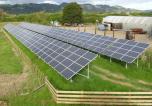Getting free power may seem like a pipe dream, but with solar power technologies getting cheaper the prospect of operating a self-sustaining building is now a reality.
“Solar electric power systems pay for themselves within about 10 years, and they’ll last as long as 40 years,” architecture firm Jasmax’s sustainability manager Jerome Partington told NBR ONLINE.
“You’re getting 30 years of free electricity.”
The concept of installing solar panels and a small generator in residential homes is getting more common, but what about commercial buildings?
Many “sustainable” commercial buildings will employ some form of solar power, often dedicated for water heating.
The roof of Auckland Airport’s international arrivals area, for example, is covered with 300sq m of solar panels which power the arrivals corridor lights.
Similarly, south Auckland’s Drury heavy engineering company SAFE uses 360 solar panels to generate 70% of its electricity needs.
There are countless examples of Kiwi businesses using green technologies to become more energy efficient, but can a building be completely self-sufficient, generating all its own power?
It has not been done in New Zealand yet, but Mr Partington says one of Jasmax’s new projects aims to achieve just that.
Tuhoe project
The building is a central administration, governance and meeting centre being built for Tuhoe in Taneatua, Whakatane, expected to be completed near the end of 2014.
With an area of about 1700sq m and 400sq m of solar panels, Mr Partington says the building will meet “net zero energy performance”.
That means it will use only the energy it produces itself over the course of the year.
Because it will be connected to the grid, it will buy power during winter when solar generation will be lower and sell it back to the grid in summer, when it will be producing more than it needs.
The net result is a zero energy cost to the building.
Overseas examples
The concept has been used in the six-storey, 4800sq m Bullit Centre building in Seattle, USA.
It has solar photovoltaic cells with the capacity to produce 230,000kWh per year.
Twenty-six geothermal wells were bored to make the heating and cooling needs more efficient, and window blinds are controlled by an on-site weather station.
Similar concepts are being used in Denmark, where the government will soon require new buildings to use just 20kWh per sq m a year for basic energy needs such as heating, lighting and ventilation.
In comparison, one of New Zealand’s most efficient “green” buildings, the NZI Centre, uses about more than 80kWh per sq m.
While that is a long way off Denmark’s goal, Mr Partington says, if it can be done in a climate as harsh as in Denmark, or as cloudy as Seattle’s, New Zealand can definitely achieve it.
“We’ve got a climate that’s three or four times more energy-rich than Denmark.
“We’ve got longer days, more sunshine, better rain – you name it – and yet we’re not exploiting that. We’re still relying on old technologies.”
via National Business Review – Caleb Allison
The Latest Streaming News: Free power updated minute-by-minute
Bookmark this page and come back often
Latest NEWS
Latest VIDEO








